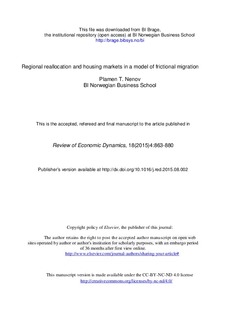| dc.contributor.author | Nenov, Plamen T. | |
| dc.date.accessioned | 2016-01-22T11:25:17Z | |
| dc.date.available | 2016-01-22T11:25:17Z | |
| dc.date.issued | 2015 | |
| dc.identifier.citation | Review of Economic Dynamics, 18(2015)4:863-880 | nb_NO |
| dc.identifier.issn | 1094-2025 | |
| dc.identifier.issn | 1096-6099 | |
| dc.identifier.uri | http://hdl.handle.net/11250/2374552 | |
| dc.description | This is the author's accepted and refereed manuscript of the article | nb_NO |
| dc.description.abstract | Migration frictions are important for understanding key features of gross migration and housing markets. This paper studies a multi-region equilibrium model with frictional migration. Idiosyncratic preference shocks, a mobility cost, and imperfectly directed migration lead to slow worker reallocation in response to changes in local conditions. This leads to a dependence of local house prices on the history of labor market shocks. The model accounts for the comovements of unemployment and rental and house prices with gross migration observed in a panel of U.S. cities. Structural estimation reveals a high mobility cost for unemployed workers and a low probability of directed migration. Both of these imply that regional reallocation has a limited importance for the aggregate labor market and that the e ects of housing markets on reallocation are small. | nb_NO |
| dc.language.iso | eng | nb_NO |
| dc.publisher | Elsevier | nb_NO |
| dc.title | Regional reallocation and housing markets in a model of frictional migration | nb_NO |
| dc.type | Journal article | nb_NO |
| dc.type | Peer reviewed | nb_NO |
| dc.source.journal | Review of Economic Dynamics | nb_NO |
| dc.identifier.doi | 10.1016/j.red.2015.08.002 | |
| dc.description.localcode | 2, Forfatterversjon | nb_NO |
